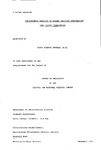AGRICULTURAL ANALYSIS BY PLASMA EMISSION SPECTROSCOPY WITH SLURRY ATOMISATION
| dc.contributor.author | SPARKES, SIMON TIMOTHY | |
| dc.contributor.other | School of Geography, Earth and Environmental Sciences | en_US |
| dc.date.accessioned | 2013-10-10T10:29:35Z | |
| dc.date.available | 2013-10-10T10:29:35Z | |
| dc.date.issued | 1986 | |
| dc.identifier | NOT AVAILABLE | en_US |
| dc.identifier.uri | http://hdl.handle.net/10026.1/2145 | |
| dc.description.abstract |
The three electrode direct current plasma (DCP), has been investigated for the analysis of samples introduced using aqueous solution nebulisation, hydride generation and slurry atomisation. For aqueous solutions, simplex optimisation with signal to background ratio as the criterion of merit, vertical viewing position was found to be most critical. A continuous-flow hydride generator was interfaced to the DCP via a modified sample introduction chimney. Optimisation indicated that total sample introduction gas flow rates were essentially similar to those for conventional nebulisation and that vertical viewing position was again critical. Generation conditions for lead hydride were also simplex optimised. Acid, sodium hydroxide, and hydrogen peroxide concentration were all found to be critical. Detection limits for hydride generation were: As 4 ng cmˉ³, Se 4 ng cmˉ³, Pb 10 ng cmˉ³. Arsenic and selenium were accurately determined in various reference materials. The determination of Mg in aqueous slurries of kaolin was optimised using the Mg(II) 279.079 nm line and conventional sample introduction. Vertical viewing position was again critical with the optimum on the boundary of the analytical zone and over the plasma core. A reduction of emission intensity at high slurry concentrations (> 12%), was observed. Particle size was the most important parameter in slurry atomisation, < 5 µm being preferred. Soils, milk, plant materials and sewage sludges were successfully analysed by slurry atomisation. Where necessary, particle size was reduced using simple grinding procedures. For fibrous materials, prior matrix carbonisation was advantageous. Results obtained using these procedures and simple aqueous calibration showed excellent agreement with certified values of reference materials. Electron number density (ne), excitation temperature (Texc) and ionisation temperature (Tion), were measured for two series of kaolin slurries, (1-20% m/V), one containing 5 g 1ˉ¹ lithium as enhancement buffer. For the slurries containing added lithium, Texc and ne were found to be reduced with increasing slurry concentration. Observed decreases in analyte emission with increased sample loadings (> 12%), are considered to be consistent with proposed excitation models. | en_US |
| dc.description.sponsorship | Agricultural Development Advisory Service, Burghill Road, Westbury-on-Trym, Bristol | en_US |
| dc.language.iso | en | en_US |
| dc.publisher | University of Plymouth | en_US |
| dc.title | AGRICULTURAL ANALYSIS BY PLASMA EMISSION SPECTROSCOPY WITH SLURRY ATOMISATION | en_US |
| dc.type | Thesis | |
| plymouth.version | Full version | en_US |
| dc.identifier.doi | http://dx.doi.org/10.24382/3229 | |
| dc.identifier.doi | http://dx.doi.org/10.24382/3229 |
Files in this item
This item appears in the following Collection(s)
-
01 Research Theses Main Collection
Research Theses Main


